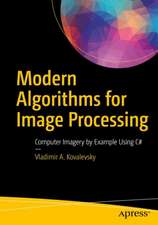Image Processing with Cellular Topology
Autor Vladimir Kovalevskyen Limba Engleză Paperback – 30 mar 2023
This book explains why the finite topological space known as abstract cell complex is important for successful image processing and presents image processing methods based on abstract cell complex, especially for tracing and encoding of boundaries of homogeneous regions. Many examples are provided in the book, some teach you how to trace and encode boundaries in binary, indexed and colour images. Other examples explain how to encode a boundary as a sequence of straight-line segments which is important for shape recognition. A new method of edge detection in two- and three-dimensional images is suggested. Also, a discussion problem is included in the book: A derivative is defined as the limit of the relation of the increment of the function to the increment of the argument as the latter tends to zero. Is it not better to estimate derivatives as the relation of the increment of the function to the optimal increment of the argument instead of taking exceedingly small increment whichleads to errors? This book addresses all above questions and provide the answers.
| Toate formatele și edițiile | Preț | Express |
|---|---|---|
| Paperback (1) | 885.49 lei 6-8 săpt. | |
| Springer Nature Singapore – 30 mar 2023 | 885.49 lei 6-8 săpt. | |
| Hardback (1) | 891.33 lei 6-8 săpt. | |
| Springer Nature Singapore – 29 mar 2022 | 891.33 lei 6-8 săpt. |
Preț: 885.49 lei
Preț vechi: 1079.86 lei
-18% Nou
Puncte Express: 1328
Preț estimativ în valută:
169.46€ • 175.06$ • 141.03£
169.46€ • 175.06$ • 141.03£
Carte tipărită la comandă
Livrare economică 25 martie-08 aprilie
Preluare comenzi: 021 569.72.76
Specificații
ISBN-13: 9789811657740
ISBN-10: 9811657742
Pagini: 184
Ilustrații: XI, 184 p. 1 illus.
Dimensiuni: 155 x 235 mm
Greutate: 0.29 kg
Ediția:1st ed. 2021
Editura: Springer Nature Singapore
Colecția Springer
Locul publicării:Singapore, Singapore
ISBN-10: 9811657742
Pagini: 184
Ilustrații: XI, 184 p. 1 illus.
Dimensiuni: 155 x 235 mm
Greutate: 0.29 kg
Ediția:1st ed. 2021
Editura: Springer Nature Singapore
Colecția Springer
Locul publicării:Singapore, Singapore
Cuprins
Chapter 1. Introduction.- Chapter 2. Boundary Presentation Using Abstract Cell Complexes.- Chapter 3. Boundary Tracing in Binary Images Using Cell Complexes.- Chapter 4. Boundary Tracing and Encoding in Color Images.- Chapter 5. Boundary Polygonization.- Chapter 6. Edge Detection in 2D Images.- Chapter 7. Surface Traversing and Encoding in 3D Images.- Chapter 8. Edge Detection in 3D Images.- Chapter 9. Discussion.
Notă biografică
Vladimir A. Kovalevsky received his diploma in physics from the Kharkov University (Ukraine) in 1950, the first doctoral degree in technical sciences from the Central Institute of Metrology (Leningrad) in 1957, and the second doctoral degree in computer science from the Institute of Cybernetics of the Academy of Sciences of the Ukraine (Kiev) in 1968. From 1961 to 1983 he served as Head of Department of Pattern Recognition at that Institute.
He has been living in Germany since 1983. From 1983 to 1989 he was researcher at the Central Institute of Cybernetics of the Academy of Sciences of the GDR, Berlin. From 1989 to 2004 he was professor of computer science at the University of Applied Sciences Berlin with an interruption for three years (1998-2001). In that time, he was scientific collaborator at the University of Rostock. He worked as visiting researcher at the University of Pennsylvania (1990), as visiting professor of computer sciences at the Manukau Institute of Technology, NewZealand (2005), at the Department of Automatic Control of the “Centro de Investigación y de Estudios Avanzados del IPN” in Mexico (2006), at the University of Applied Sciences Wildau, Germany (2008) and at the Chonbuk National University, Korea (2009). He has been plenary speaker at conferences in Europe, America and New Zealand. His research interests include digital geometry, digital topology, computer vision, image processing and pattern recognition. He has published four monographs and more than 180 journal and conference papers in image analysis, digital geometry and digital topology.
Textul de pe ultima copertă
This book explains why the finite topological space known as abstract cell complex is important for successful image processing and presents image processing methods based on abstract cell complex, especially for tracing and encoding of boundaries of homogeneous regions. Many examples are provided in the book, some teach you how to trace and encode boundaries in binary, indexed and colour images. Other examples explain how to encode a boundary as a sequence of straight-line segments which is important for shape recognition. A new method of edge detection in two- and three-dimensional images is suggested. Also, a discussion problem is included in the book: A derivative is defined as the limit of the relation of the increment of the function to the increment of the argument as the latter tends to zero. Is it not better to estimate derivatives as the relation of the increment of the function to the optimal increment of the argument instead of taking exceedingly small increment whichleads to errors? This book addresses all above questions and provide the answers.
Caracteristici
Introduces abstract cell complex as an important tool for image processing research Proposes boundary tracing and encoding methods based on abstract cell complex Presents image processing as an application area to topological research community

























